How Madrid Became One of Europe's Best Food Cities
The Spanish capital has transformed its formerly staid restaurant scene into a hotbed of global culinary talent.
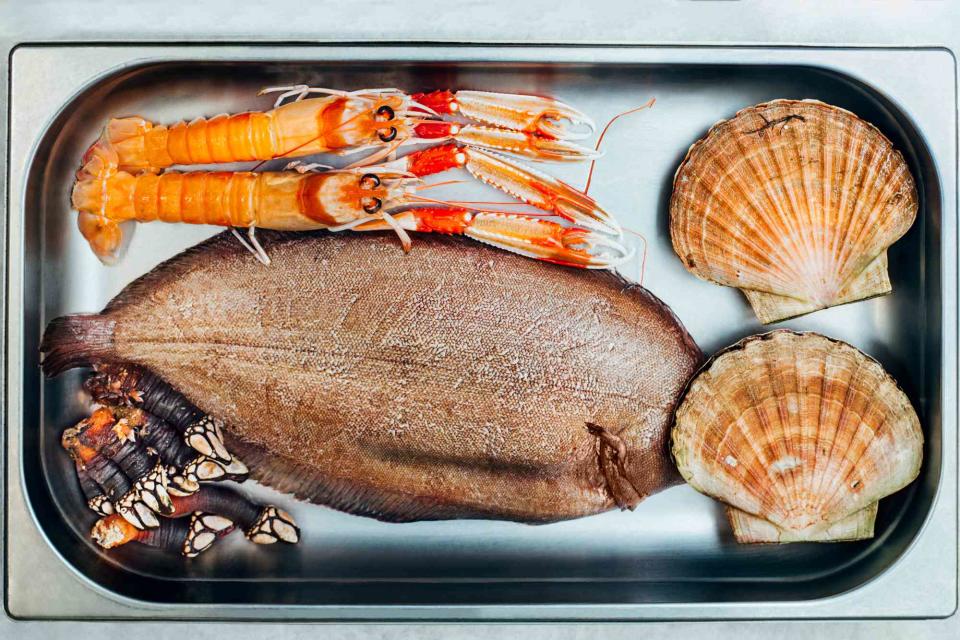
James Rajotte
Fresh seafood awaits preparation at Madrid's Desde 1911.By all accounts, I should have been thinking about Egyptian-cotton thread counts and gilded tea services on the bullet train back to Barcelona. After all, that’s why I had gone to Madrid in the first place.
It was July 2021, Year 2 of our Cruel Mistress Corona. I had traveled with my wife to my adopted nation’s capital to stay at the newly renovated and rebranded Mandarin Oriental Ritz, one of Europe’s most famous hotels. As impressive as the property was, my mind was fixed on the kinetic culinary energy I’d witnessed in the city. The markets were abuzz with casual vendors and towering food stands. Sidewalks teemed with people emerging from a series of lockdowns and restrictions, the latest of which had been lifted just two months before. New openings weren’t just surviving the pandemic, but thriving.
I’ve lived in Spain since 2010, and have always admired Madrid, but I’ve spent more time in the Prado Museum feasting on Hieronymus Bosch’s Garden of Earthly Delights than in the restaurants, which felt either too old or too formal to register on my personal Richter scale.
But during my last few trips, I felt a hunger stirring in me normally reserved for journeys to Asia. I found myself craving meals, compiling lists, and fantasizing about elaborate food crawls through the city’s many distinctive neighborhoods.
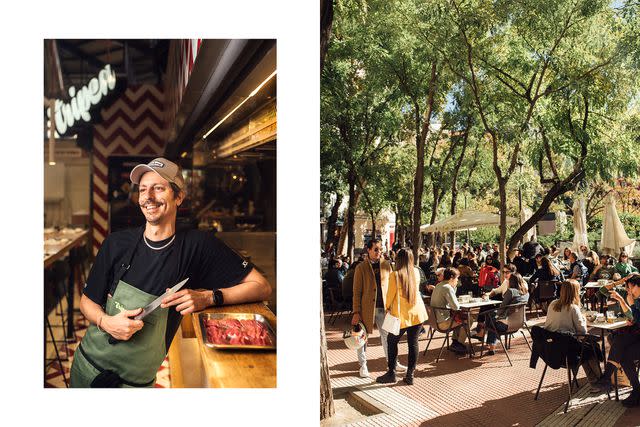
James Rajotte
From left: Chef Roberto Martínez prepares for dinner at Tripea; Plaza Olavide, a popular square in Madrid's Chamberí neighborhood.On that 2021 trip, even my wife, a born-and-bred Catalan with a serious Barcelona bias, was impressed. “Do you think their food scene is better than ours?” The fact that she was asking the question, and that I didn’t have a clear answer, was proof enough that something was afoot in the Spanish capital.
What was going on? While the rest of the food world was focusing on staying afloat, had Madrid become one of the most exciting eating destinations on earth? I decided, right there on the train barreling toward Barcelona, that I’d make it my duty to get back there as soon as possible and get to the bottom of it.
To help me understand the capital’s place in the pantheon of global food destinations, I enlisted the help of a close friend, Patricia Mateo, whose work doing restaurant branding and consulting at the Madrid-based Mateo&Co has put her on the front lines of the current culinary transformation.
Even my wife, a born-and-bred Catalan with a serious Barcelona bias, was impressed. “Do you think their food scene is better than ours?” The fact that she was asking the question, and that I didn’t have a clear answer, was proof enough that something was afoot in the Spanish capital.
In one of a dozen excited messages exchanged about the topic, Patricia told me that “the most visited landmark isn’t the Prado; it’s San Miguel!” Not a world-famous museum housing the works of Goya and Picasso, but a food market bursting with the tastes of jamón and saffron-stained paella. I proposed a simple plan: show me the full breadth of Madrid’s brilliance in one day, as if it were one giant tapas crawl. And so, six months after my trip to the Ritz, we set off.
We started at Cientotreinta°, a bakery in the Chamberí neighborhood that opened in 2017. Normally I wouldn’t have filled up on bread at the start of a high-calorie bender, but this was no ordinary bread. Alberto Miragoli, who trained at top bakeries across the U.S. and Europe, creates heroic loaves with a shattering crust, a soft, airy crumb, and an aroma redolent of toasted grain. At the front of the shop, Alberto’s brother Guido makes some of the city’s best coffee to accompany a vast selection of pastries. Our next stop was Formaje, where Clara Diez has put together one of the most impressive cheese collections in Spain. Patricia had chosen it to make a point: you can’t have world-class cuisine without world-class purveyors. “These are the building blocks for greatness,” she said.
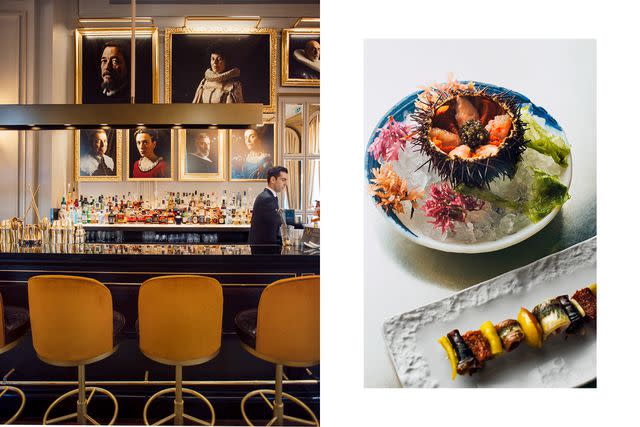
James Rajotte
From left: Pictura, the bar at Mandarin Oriental Ritz, Madrid; sea urchin with shrimp and caviar accompanied by a seafood skewer at Estimar.To understand what all these blocks add up to, we went to one of the city’s newest openings, Chispa Bistró. Juan D’Onofrio and Gabriel Sodré are South American chefs channeling years of work in Spain’s elite spots (El Celler de Can Roca, Santceloni, Enigma) into a place that feels like a casual neighborhood joint — while serving food worthy of a destination restaurant. Dominoes of bonito from Spain’s Atlantic coast were smoked over thyme and sage, then served with pistachios, ponzu, and umbrellas of spicy nasturtium. Chispa’s pastrami was marinated in coffee and rubbed in six different varieties of peppercorns before being laid across a sunchoke purée and finished with a rich osso buco demi-glace.
“We are tasting a generational shift,” Patricia told me as we lapped up the last bit of pastrami jus. “We’ve been eating out a few times a week for ten or fifteen years. We know what’s good. Our chefs have traveled, and cooked at the best restaurants, and know how to put the Spanish bounty to work.”
Pedigree plus product plus a local population that lives to eat? An unfailing formula for a serious food culture.
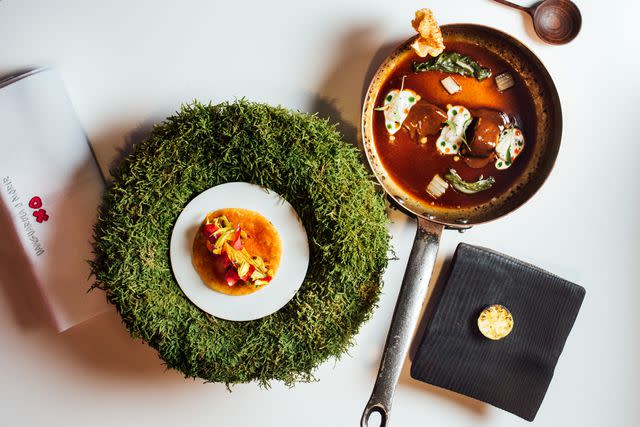
James Rajotte
At DiverXO, a squash-blossom taco on a bed of moss sits next to rooster stew made with beans, citrus, and herbs.The formula was in full effect at our second lunch stop, Desde 1911, opened last year and one of Madrid’s most momentous recent debuts. Famous fish purveyor Pescaderías Coruñesas spent millions converting a nondescript industrial space into a soaring church of seafood worship. The gospel here is an oft-repeated axiom of Madrid’s culinary class: that the best port in Spain is in Madrid, despite it being hundreds of miles from the nearest ocean. It’s an adage that I had always been suspicious of, but lunch that day made me a convert.
The meal began the way it ended, with a tableside cart. In this instance, one bearing a plank of smoked salmon. A well-dressed gentleman ceremoniously carved veils of fish and placed them before us like communion wafers. I put one on my tongue and closed my eyes and felt something close to religion.
Related: The Best Times to Visit Spain for Great Weather and Famous Festivals
One by one, the carts arrived bearing Madrid’s best ingredients: half a dozen breads; an embarrassment of seasonal desserts; a cheese cart that would have few equals in Paris. The most important of the carts wheeled out the day’s selection of seafood (gooseneck barnacles smelling of Galicia, red shrimp the size of small lobsters). Choose the ones you want and they’ll return to your table transformed into little love letters to the ocean.
At the center of it all was the day’s catch: an oven-roasted Atlantic kingfish. Abel Valverde, the restaurant’s general manager, who is legendary for his all-in hospitality, put on a show for diners at a tableside cooktop, first deboning the fish, then whipping up a sauce. It was made with the juices of the fish head, tail, and bones, which he squeezed in a gorgeous apparatus that reminded me of a duck press — a contraption invented in 19th-century France that is used to extract the jus, blood, and marrow of a duck, which then goes into a sauce for the meat. The performance was ostentatious and perhaps overly theatrical, but it hit the high-wire balance of classic and modern, polished and relaxed, style and substance.
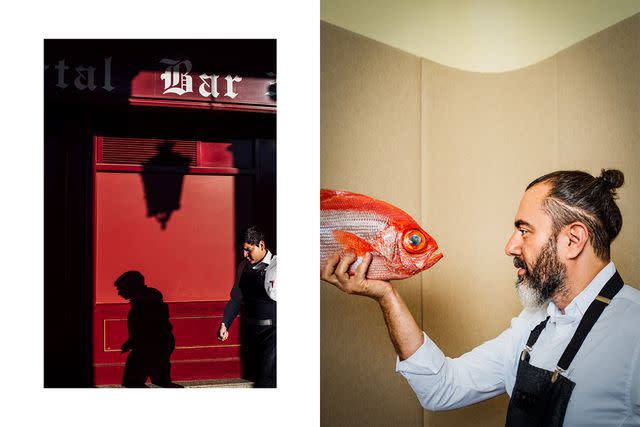
James Rajotte
From left: A restaurant server on Plaza Mayor, Madrid's main public square; chef Rafa Zafra sizes up the night's dinner—red snapper—at his restaurant, Estimar.But if anyone represents Madrid’s rising dominance of the seas, it’s Rafa Zafra. When he opened a Madrid branch of his Barcelona jewel box Estimar, the city’s deep-pocketed seafood savants lined up to experience the best of the country’s marine ingredients. Think wild turbot from the Basque coast, thumb-size barnacles from Galicia, and the fattest red prawns straight from the Costa Brava.
“Ten years ago, you ate cocido and T-bones and little more,” Zafra said. “But the change has been fast and dramatic. Now it’s not just Spanish cuisine, but the best Japanese restaurants, the best Mexican restaurants, the best Peruvian restaurants in Europe are in Madrid. People want to be here — chefs and diners.”
After a postprandial power walk and siesta, Patricia and I concluded our crawl at one of the city’s enduring culinary institutions, one that one chef had described to me as “the birthplace of foodies”: Sacha.
More than a foodie, Sacha Hormaechea is a chef, server, sommelier, host, and poet laureate of the Madrid kitchen, a man who has turned long meals and longer post-meal conversations into an art form. After 51 years of soul-stirring cooking and candlelit bonhomie, Sacha feels more like a private dinner club than a restaurant. The dishes zero in on all the right pleasure centers: abuela-approved pots of simmered lentils, briny-sweet spider-crab ravioli with sea urchins and jalapeño-infused oil, an unctuous tortilla with islands of smoky chorizo and pickled pepper.
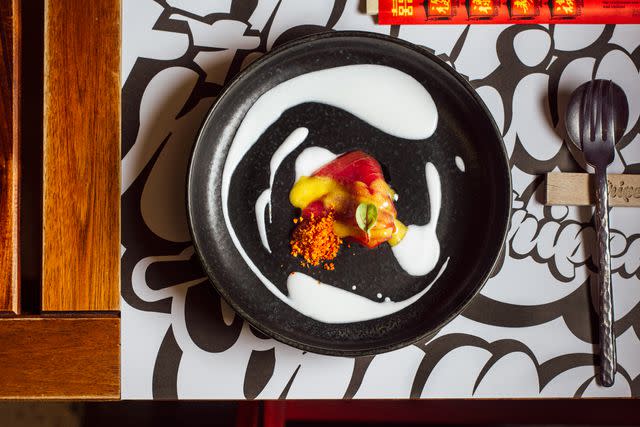
James Rajotte
Tripea's tuna tartare, made with passion fruit, fermented garlic, panko, and chili.For all Patricia’s expertise and enthusiasm, I decided that I needed an impartial voice in matters of Madrid. Someone with a good palate, a finger on the culinary pulse, who knows Spain, but has no special allegiances to one city or region over the other. Luckily, I knew just the guy.
“Something is happening here.” It had been years since René Redzepi was last in Madrid, and the influential chef (whose Copenhagen restaurant, Noma, will be closing its doors at the end of 2024) couldn’t stop talking about the changes. “You can feel it in the air.” Redzepi and I, who had been developing a food series for Apple TV called Omnivore, met up in Madrid for some serious eating.
The evidence was all around us. Maxed-out waiting lists. Well-dressed young people with euros burning holes in their designer pockets. Post-work crews stacked two deep on the sidewalks surrounding the bars and restaurants.
We were in a cab cutting through the Madrid night. We had already finished a two-stop warm-up: At El Doble, the venerable tavern, we drank vermouth, crunched potato chips fried in olive oil, and slurped the heads of lightly boiled shrimp. At Arima, the big-hearted Basque chef Rodrigo Garcia hit us with the kind of casual culinary wizardry — roasted piquillo peppers stuffed with oozing ribbons of salt-cod brandade, Spanish corn tortillas called tallo wrapped around plump house-made blood sausage — that keeps his cozy neighborhood spot filled with off-duty chefs.
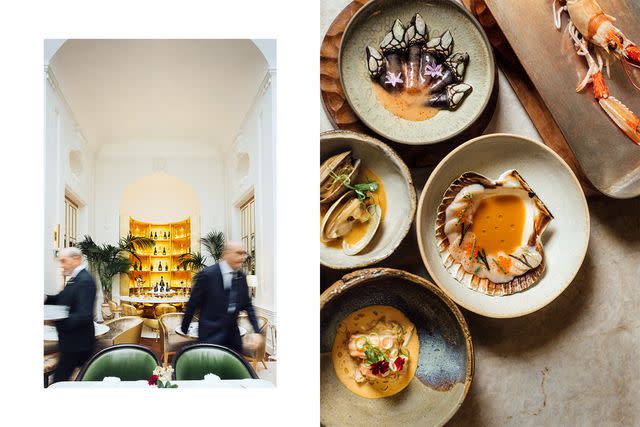
James Rajotte
From left: The Palm Court restaurant at the Mandarin Oriental Ritz, in Madrid; goose barnacles, crayfish, scallops, lobster, and clams at Madrid's Desde 1911 restaurant.But the one thing every first-rate food city needs is a destination restaurant: a place so devastatingly delicious and groundbreaking that it inspires people around the world to build entire itineraries around one meal. In Madrid, that restaurant is DiverXo, the Michelin three-starred modernist temple helmed by Dabix Muñoz.
Known for his sculpted mohawk, rebel spirit, and complex, globe-spanning creations, Muñoz trades in a brand of showmanship and culinary swagger that consistently raises eyebrows.
“This is salad from the back of the fridge,” said the server, describing one of the night’s first courses.
Of all the seismic shifts in this city’s dining scene, it may be the influx of global cuisine that has helped elevate Madrid dining to a new standard.
Redzepi and I glanced at each other as we took in the description, a collision of ingredients that sounded more like a word-association game than a recipe. But the first bite left no room for doubt: a cooling vegetal blast, crunchy nodes of tomato seed punctuated by doses of acidity. In the center of the table sat pieces of three different fish — red mullet, turbot, sea bream — all cooked over charcoal, all showstoppers.
The dinner that followed was composed of at least a dozen creations that left me mumbling “WTF” to myself, dishes that defied logic, that seemed to break the laws of gastrophysics: foie gras and sea urchin spiked with horseradish and jalapeño; baby-eel sashimi dressed with arbol chile and sweet vermouth; lobster by way of Goa, with a tandoori char, and a thatch of crispy purple rice.
“My cooking is like Black Mirror,” Muñoz said with a roguish smile. “You never fully understand where something is going. At first you don’t grasp the plot, but when you finish, it all makes sense.”
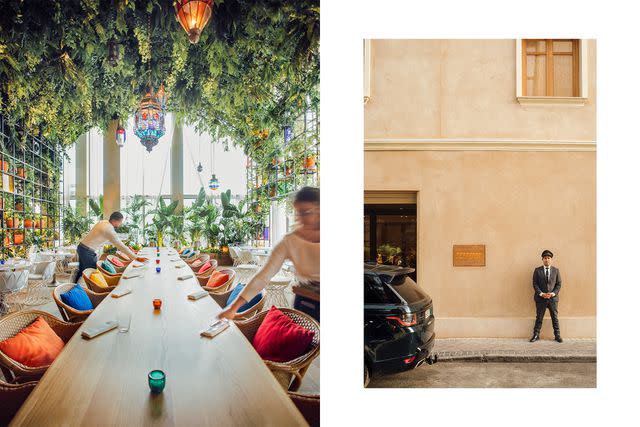
James Rajotte
From left: Oroya, the Peruvian restaurant helmed by chef Diego Muñoz at the Madrid Edition hotel; valet Salvador Lopez awaits diners at Desde 1911.In less talented hands, DiverXo would be a disaster. But Muñoz has been given the greatest gift a chef can have — a preternatural understanding of what makes food taste incredible.
It was a privilege to try the work of one of the culinary world’s most strident maximalists beside one of its most famous minimalists. For every ingredient that Redzepi removes from his plates, Muñoz adds four, but game recognizes game, regardless of how it arrives at the table.
Since it has only 32 seats, only a few thousand people a year get to eat at DiverXo, but the ripple effect of the place — breeding and inspiring new talent, opening pathways for better purveyors, expanding the popular palate — has changed Madrid forever. “In the past five years, the city has gone through a radical culinary transformation,” Muñoz said. “It used to be a classic dining city, less risky, but all of that has changed.”
Take Javi Estévez’s La Tasquería, an outpost of offal-centric alchemy where the casual vibe belies the seriousness of the cooking. Estévez specializes in a form of extreme surf and turf: squid come stuffed with cockscomb, sweet red shrimp conspire with the lip-smacking riches of pig’s feet. But his greatest hit is a stand-alone star — a suckling pig’s head, first simmered in its own fat, later fried to a state of shattering crunchiness, then served with a thatch of lettuce and raw onion. This is what the Spaniards call la cocina de aprovechamiento, where nothing goes to waste. Whether or not you dig pig’s head and cockscomb, a city that turns the “off bits” into packed restaurants and Michelin stars is, undeniably, an enlightened place.
Once upon a time, you could find the best Galician or Asturian or Murcian cooking in Madrid, but barely find a dumpling or a Thai curry worth eating. Of all the seismic shifts in this city’s dining scene, it may be the influx of global cuisine that has helped elevate Madrid dining to a new standard.
You want first-rate tacos and a Oaxacan-level mezcal list? Head to Barracuda MX, where Roberto Ruiz makes little miracles out of corn and chiles and seafood in a dozen permutations. The chef behind PuntoMX, the first Michelin-starred Mexican restaurant in Europe (which has since closed), Ruiz has been preaching the gospel of dried peppers and nixtamalized corn in Madrid for 11 years now, priming eaters for more daring interpretations of a cuisine they once scarcely knew.
At Soy Kitchen, you can lose yourself in a flurry of inventive dim sum, like pork ribs and peanuts lashed with Sichuan peppercorns, say, or oxtail-and-kimchi gyoza. Writing about the embarrassment of Japanese restaurants across the capital would require a story of its own, but just know that Ikigai, Umiko, and Kappo, are some of Europe’s greatest sushi counters.
My favorite of the new wave of international options comes from the 35-year-old Peruvian chef Roberto Martínez Foronda, who opened Tripea in Madrid’s Vallehermoso market in 2017. Foronda has exactly the kind of background that is helping fuel the city’s extraordinary culinary renaissance, having trained under Mitsuharu Tsumura back in Lima and with the Roca brothers at El Celler de Can Roca, in Catalonia.
“The fusion boom in Madrid created so much bad food,” Foronda said in what could be boilerplate language for fusion booms the world over. “But we’ve cut through the fat and what’s left is mostly excellent.”
To prove his point, he unleashed a six-course dinner at his buzzing 12-seat counter worthy of his résumé: oysters given the ceviche treatment with a strawberry leche de tigre; grilled sweetbreads crowned with a light air of laksa that has all but disappeared by the time you bite down, leaving just a whisper of its spice and acidity behind; a melting slab of brownie made with lucuma, a fruit native to the Andes, laced with chile and black mole.
Despite the meandering menu, nothing felt forced, and though some bites inevitably worked better than others, everything I ate at Tripea felt new.
“Madrid always had the old-school roots,” Foronda said, trucker hat and facial hair framing his face. “Suddenly, it’s a young food city.”
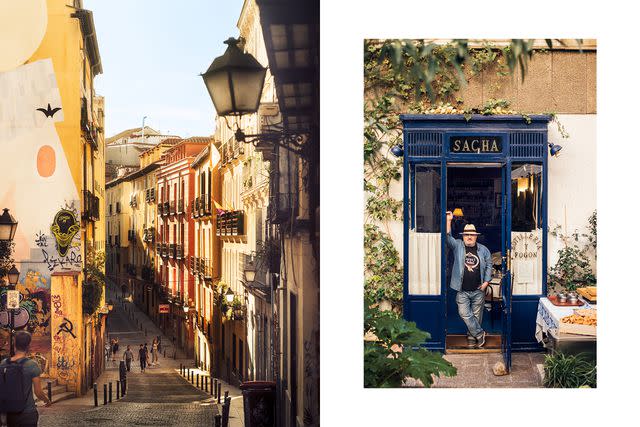
James Rajotte
From left: A view down Calle Calvario, in Madrid's Lavapiés neighborhood; chef Sacha Hormaechea at his namesake restaurant.On my last night in Madrid, after dozens of big meals, I wanted nothing more than a few antacids and my hotel bathrobe for dinner. But there was one person’s cooking in this town that could rouse me from a self-imposed fast.
In the spring of 2022, Dabix Muñoz opened RavioXo, an ode to the world of gyoza, empanadas, ravioli — you know, stuffed dough. “I always had a dream of opening a dumpling bar,” Muñoz said, “but I wanted it to be more radical, more boundary-pushing.”
It’s hard to think of a more apt description of what goes down in the kitchen at RavioXo. One chef dressed cold fried chicken with ribbons of carbonara. Another blasted a batch of rigatoni in a perforated wok wreathed in flames. The American chef de cuisine, Balo Ortiz, slid plate after plate — hot-and-sour tortellini, chipotle partridge ravioli — in my direction. Every few bites, I found myself scribbling down another expletive in my notebook.
“It’s the kind of restaurant I couldn’t have opened in Madrid before,” said the chef. Now it feels like the kind of place that he could have opened only here.
While I took a taxi back to my hotel, the pilot lights in the city’s kitchens still burned bright. The modern tapas bars near Retiro Park pumped out plates of razor clams and acorn-fed ham. A line of thirsty revelers formed outside Diego Cabrera’s celebrated cocktail lounge, Salmon Guru, looking for tiki drinks and fancy bar snacks. Somewhere nearby, a fish press extracted the last bit of juice from the day’s catch. It was just a Tuesday, a few minutes past midnight, but the feast showed no sign of ending anytime soon.
Madrid Is More Than Great Restaurants...
If there were ever any doubt about Madrid’s ascendancy as a global culinary destination, its hotels offer conclusive proof. While each of the following places has its own DNA, they’re united by a deep dedication to food and a growing place in the hearts of the Madrileños who flock to their lobbies, bars, and restaurants to eat, drink, and ponder life among the tide of visitors.
Four Seasons Hotel Madrid: A project of seemingly impossible scale, the property — steps from the Plaza del Sol — united seven historic buildings in the heart of central Madrid and opened in 2020. It’s a testament to the city’s soaring ambitions.
The Madrid Edition: What do you get when you combine a sumptuous, plant-filled terrace with food from Mexican chef Enrique Olvera and the overall sexy vibes that Edition has refined across its global portfolio? One of Madrid’s most vibrant, youthful new hotels — and it’s within walking distance of the city’s major cultural sites, including the Prado.
Mandarin Oriental Ritz, Madrid: A storied 1910 property that took on new life after a massive $100 million overhaul and rebranding — and from the look, feel, and taste of the place today, it was worth every penny. Beyond the high thread counts and perfect Prado-adjacent location is one of the hotel world’s most ambitious food programs, captained by Quique Dacosta, a Valencian with a small galaxy of Michelin-starred restaurants to his name.
Rosewood Villa Magna: If the Four Seasons and the Ritz are the city’s glamorous, high-profile debuts, Rosewood is the one that oozes quiet confidence from its privileged perch at the edge of Madrid’s Salamanca neighborhood. You get the feeling, while sipping a martini or tucking in to Jesús Sánchez’s seafood-forward dishes at Amós Restaurant, that you’re sitting among the city’s elite as they figure out their next big moves.
A version of this story first appeared in the July 2023 issue of Travel + Leisure under the headline "Cocina Madrileña."
For more Travel & Leisure news, make sure to sign up for our newsletter!
Read the original article on Travel & Leisure.

